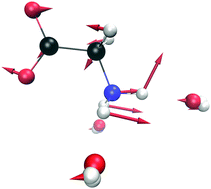Mode specific THz spectra of solvated amino acids using the AMOEBA polarizable force field†
Abstract
We have used the AMOEBA model to simulate the THz spectra of two zwitterionic amino acids in aqueous solution, which is compared to the results on these same systems using ab initio molecular dynamics (AIMD) simulations. Overall we find that the polarizable force field shows promising agreement with AIMD data for both glycine and valine in water. This includes the THz spectral assignments and the mode-specific spectral decomposition into intramolecular solute motions as well as distinct solute–water cross-correlation modes some of which cannot be captured by non-polarizable force fields that rely on fixed partial charges. This bodes well for future studies for simulating and decomposing the THz spectra for larger solutes such as proteins or polymers for which AIMD studies are presently intractable. Furthermore, we believe that the current study on rather simple aqueous solutions offers a way to systematically investigate the importance of charge transfer, nuclear quantum effects, and the validity of computationally practical density functionals, all of which are needed to fully quantitatively capture complex dynamical motions in the condensed phase.



 Please wait while we load your content...
Please wait while we load your content...